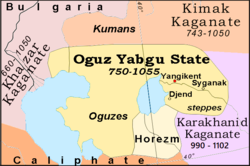Oghuz Yabgu State
| Oghuz Yabgu State | ||||||||||||
| Kaganate | ||||||||||||
|
||||||||||||
|
Oguz Yabgu State in Kazakhstan, 750–1055
|
||||||||||||
| Capital | Yangikent | |||||||||||
| Languages | Turkic | |||||||||||
| Religion | Tengriism | |||||||||||
| Political structure | Kaganate | |||||||||||
| Historical era | 8th–11th centuries | |||||||||||
| • | Established | 750 | ||||||||||
| • | Disestablished | 1055 | ||||||||||
|
||||||||||||
in Anatolia
Artuqid dynasty
Saltuqid dynasty
in Azerbaijan
Ahmadili dynasty
Ildenizid dynasty
in Egypt
Tulunid dynasty
Ikhshidid dynasty
in Fars
Salghurid dynasty
in The Levant
Burid dynasty
Zengid dynasty
in Yemen
Rasulid dynasty
The Oguz Yabgu State (Oguz il, meaning Oguz Land, Oguz Country, 750–1055) was a Turkic state, founded by Oguz Turks in 766, located geographically in an area between the coasts of the Caspian and Aral Seas. Oguz tribes occupied a vast territory in Kazakhstan along the Irgiz, Yaik, Emba, and Uil rivers, the Aral Sea area, the Syr Darya valley, the foothills of the Karatau Mountains in Tien-Shan, and the Chui River valley (see map). The Oguz political association developed in the 9th and 10th centuries in the basin of the middle and lower course of the Syr Darya and adjoining the modern western Kazakhstan steppes.
The etymology of the name "Oguz" is unclear. It was discussed many times in historical and philological literature. The term probably means "tribes", or the "tribal union", and then could turn into a collective ethnic name. The original Oguz areas were the south-eastern regions of Central Asia. The beginning of the early Oguz group formation is linked to the Western Zhetysu (often known, in Russian and other European languages, as Semirechye).
...
Wikipedia

